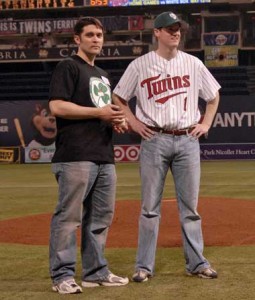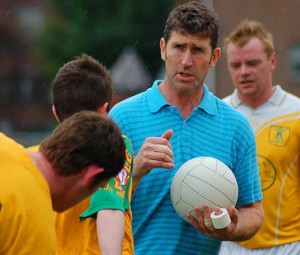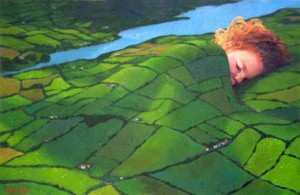
John Fitzgerald and Irish National Team first baseman Joe Kealty at a Minnesota Twins game.
By Paul Schneider
Sometimes you find the answers when you’re not really looking for them. That was the case for John Fitzgerald, a New York-based independent film producer who stumbled upon the Irish National Baseball Team a few years ago. Fitzgerald, who initially hoped to play for the squad, instead became fascinated at the prospect of chronicling their adventures.
The result is “The Emerald Diamond,” which will have a Philadelphia area screening on Saturday, March 24, at 1 p.m. in Newtown, Bucks County.
The 90-minute film, which won the Critic’s Choice Award at the National Baseball Hall of Fame Film Festival in Cooperstown, N.Y., last year,will be shown at the historic Newtown Theater, at 120 N. State Street in Newtown (215-968-3859). Tickets are $20. Alternatively, DVDs and other “Emerald Diamond” merchandise are available at the film Web site, www.irishbaseballmovie.com.
For Fitzgerald – filmmaker, baseball fan and Irish-American – the project was a labor of love. In the Q&A below, he speaks a bit about how the project unfolded, and how the personal rewards that came with creating the film.
Q. What led you to the Irish baseball topic?
A. I found the Irish National Team’s Web site during a Google search in early 2004. I don’t remember what I was looking for, but I couldn’t believe baseball was played in Ireland. As an Irish-American and a former high school/college player, my first instinct was to contact them to see if I could join the team.
At that point, I was 27 years old. I had stopped playing baseball a few years before and I had been working in TV and film – first as a production assistant (NYPD Blue, Ladder 49). I had also produced a couple of independent short and feature films. I had only directed one film – a short film called “Gorilla Gram.”
After speaking with the guys on the team by phone and e-mail, I was fascinated with the story and ready to play. It turned out that I am not eligible to claim Irish citizenship, as none of my parents or grandparents were born in Ireland. At that point, I was completely taken by the story and I figured if I couldn’t make a movie about two things I love – baseball and Ireland – I should just quit the movie business. So I called up my friend Bill Winters – a professional cinematographer who I’ve known since Little League – and we drove up to Rhode Island in May of 2004 to start shooting interviews with volunteer coaches who had been working with the Irish since 2001. The interviews went well, so we booked flights to meet the guys in Dublin in June of 2004.
Q. How much time did you spend with the Irish team?
A. Shooting started in May of 2004 and ended in September of 2005. I made several trips to Dublin, one trip to Germany for the European Championships – Ireland placed third. Each trip lasted one or two weeks and then I’d head back to New York and edit and decide what else I needed when I went back again.
I also grabbed interviews anytime an Irish player or coach came to New York. One player had his wedding in New York, enabling me to get hours and hours of interviews without having to pay for airfare. As I said, there are several coaches who live in Rhode Island – they hosted the Irish National Team in 2001 for two weeks, and even got them an exhibition game at Fenway Park. The Rhode Island coaches were great in terms of doing interviews and digging up old photos and videos. The cooperation between Americans and Irish really helped keep the cost of the project down – I was financing the movie on credit cards and flying back and forth really pushed my credit cards to the limit. Thankfully, there was always someone passing through New York or within a few hours’ drive who was kind enough to give me a few hours out of their vacation or business trip to do an interview.
Q. What was the most surprising thing you found?
A. The most surprising thing I found was that the Irish didn’t really know how to play at first. They knew that they could represent their country if they became the official National Baseball Team of Ireland. But most of the guys had never played a game and some didn’t even know the rules. The extent of their experience was that several of the guys had spent a summer or two in America and watched baseball – some had played pickup games, but that was it. These guys took on a tremendous risk by spending over a year of learning the game and traveling to the European Championships in 1996, but they did it because they wanted the honor of representing Ireland. It was surprising and refreshing to see that kind of dedication.
Q. Are there any particular incidents that stand out?
A. The story of Irish baseball is really just one amusing anecdote after another, which is what led me to do the movie. As far as filming goes, there were a few times when a player would mention something during an interview that was just so incredibly funny that I couldn’t stop laughing. For instance, there is a segment about the horrible weather that they play in. The thing is, the guys in Ireland have to play through all sorts of weather – if they start canceling games or having rain delays, they would never get any games played. Many times it can be sunny and warm and it will become cold and rainy in minutes.
I was interviewing former National Team catcher and current head coach Sean Mitchell about the weather. Sean was very understated and matter-of-fact as he recounted different times that he had played in high winds, drenching rains, etc. I asked if he could remember a rain delay or game postponement… Sean replied that the week before he was up at bat and had been hit in the eye by a hailstone – the game was stopped for five minutes before he stepped back into the batter’s box. At that point, Bill (cameraman) and I started laughing uncontrollably at how nonchalant he had just told us this story. The understated, low key nature of the team turned out to be a source of a great deal of the film’s humor.
Q. Is there anything else you would like to add?
A. The only other thing I would add is that over the course of filming, I became a huge fan of what these guys have accomplished. They are going to lose half their funding now that baseball is out of the Olympics, so I’ve started a charity to help them raise funds in the U.S. The charity is called Emerald Diamond USA and the Web site is www.SupportIrishBaseball.com. The funds raised go to the continued development of youth baseball programs in Ireland.



